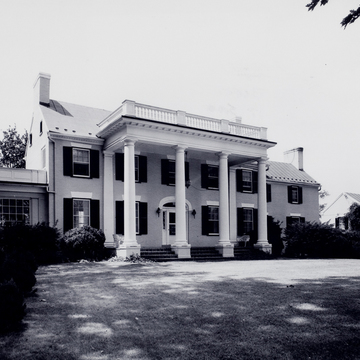When John Augustine Washington II, yet another great-nephew of George Washington, built Blakeley, he knew that he would one day inherit Mount Vernon and move there. Consequently, he planned his house on a more modest scale than those of other family members, especially his brother's exactly contemporaneous Claymont Court ( JE12), which Blakeley faces across a half-mile expanse of meadow. As built, Blakeley was a two-story, three-bay, Federal brick house with a side wing extending to the west. After Washington moved to Mount Vernon in 1829, Blakeley became a summer home. It burned in the 1860s but was rebuilt along its original lines.
Raymond J. Funkhouser, who lived at Claymont Court, purchased the house in the 1940s and rehabilitated it for his son, Justin. Among many alterations, he changed the fenestration to create a five-bay facade, added a giant-order Roman Doric portico, and replaced the rectangular transom over the front door with an elliptical arch. The result is undeniably impressive, although Blakeley now bears little external resemblance to the house the Washingtons knew.

